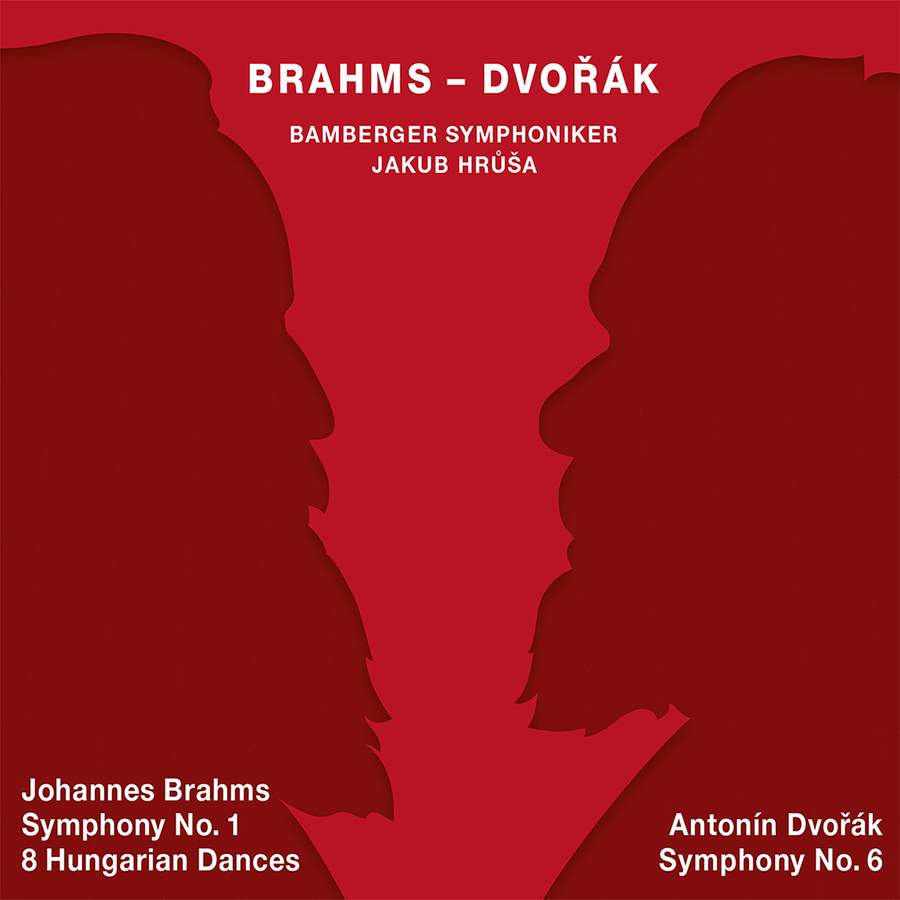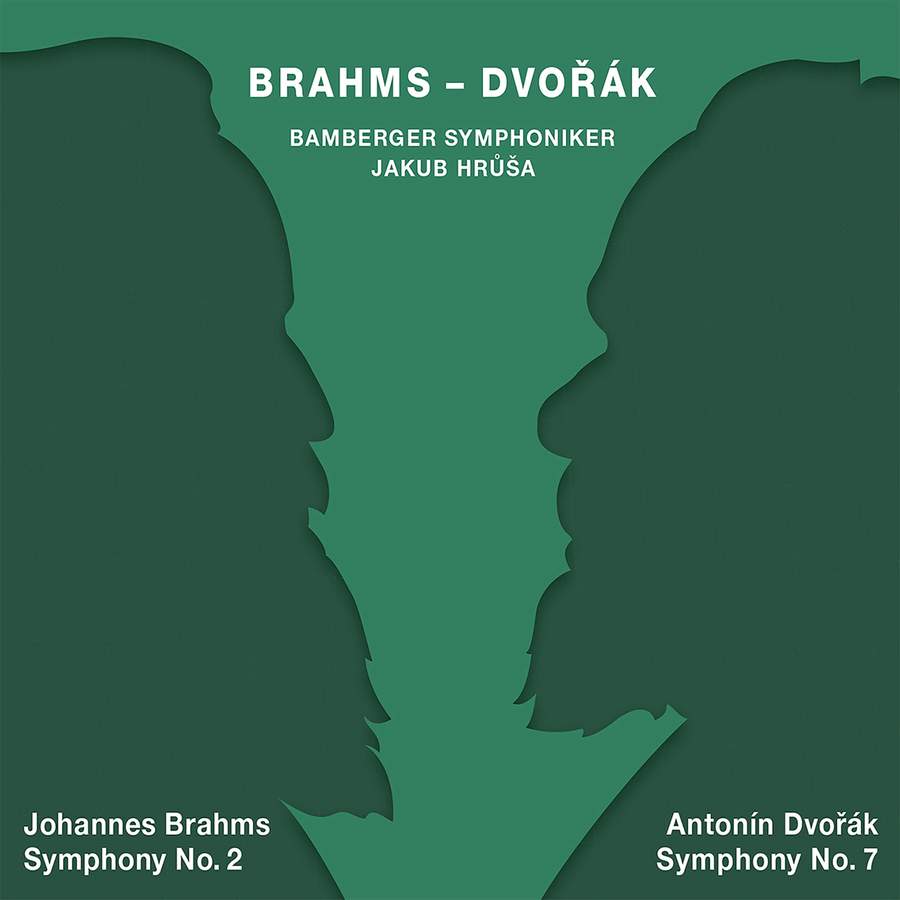BRAHMS Symphonies Nos 1& 2 DVORÁK Symphonies Nos6 & 7 (Hrůša)
View record and artist detailsRecord and Artist Details
Genre:
Orchestral
Label: Tudor
Magazine Review Date: 12/2022
Media Format: Super Audio CD
Media Runtime: 111
Mastering:
DDD
Catalogue Number: TUD1741

Tracks:
| Composition | Artist Credit |
|---|---|
| Symphony No. 1 |
Johannes Brahms, Composer
Bamberger Symphoniker Jakub Hrusa, Conductor |
| (21) Hungarian Dances, Movement: No. 1, Allegro molto |
Johannes Brahms, Composer
Bamberger Symphoniker Jakub Hrusa, Conductor |
| (21) Hungarian Dances, Movement: No. 3, Allegretto |
Johannes Brahms, Composer
Bamberger Symphoniker Jakub Hrusa, Conductor |
| (21) Hungarian Dances, Movement: No. 10, Presto |
Johannes Brahms, Composer
Bamberger Symphoniker Jakub Hrusa, Conductor |
| Symphony No. 6 |
Antonín Dvořák, Composer
Bamberger Symphoniker Jakub Hrusa, Conductor |
| (21) Hungarian Dances, Movement: No. 17, Andantino |
Johannes Brahms, Composer
Bamberger Symphoniker Jakub Hrusa, Conductor |
| (21) Hungarian Dances, Movement: No. 18, Molto vivace |
Johannes Brahms, Composer
Bamberger Symphoniker Jakub Hrusa, Conductor |
| (21) Hungarian Dances, Movement: No. 19, Allegretto |
Johannes Brahms, Composer
Bamberger Symphoniker Jakub Hrusa, Conductor |
| (21) Hungarian Dances, Movement: No. 20, Poco allegretto |
Johannes Brahms, Composer
Bamberger Symphoniker Jakub Hrusa, Conductor |
| (21) Hungarian Dances, Movement: No. 21, Vivace |
Johannes Brahms, Composer
Bamberger Symphoniker Jakub Hrusa, Conductor |
Genre:
Orchestral
Label: Tudor
Magazine Review Date: 12/2022
Media Format: Super Audio CD
Media Runtime: 85
Mastering:
DDD
Catalogue Number: TUD1742

Tracks:
| Composition | Artist Credit |
|---|---|
| Symphony No. 2 |
Johannes Brahms, Composer
Bamberger Symphoniker Jakub Hrusa, Conductor |
| Symphony No. 7 |
Antonín Dvořák, Composer
Bamberger Symphoniker Jakub Hrusa, Conductor |
Author: Andrew Farach-Colton
I was listening to this pair of two-disc sets – completing Jakub Hrůša and the Bamberg Symphony’s series juxtaposing the last four symphonies of Dvořák with Brahms’s four – when it was announced that Hrůša had been named designate music director of the Royal Opera House starting in 2025. And I remembered that I’d noted several moments in these recordings where I’d felt the suggestion of an operatic scenario – the dark, searching atmosphere at 1'29" in the Poco adagio of Dvořák’s Seventh, for example, or the weirdly creepy passage at 3'41" in that same symphony’s finale.
In any case, this series, recorded between 2017 (soon after Hrůša became the orchestra’s principal conductor) and 2020, documents the growing rapport between Hrůša and the Bambergers. I can’t say there are notable interpretative revelations here, but the performances are hugely enjoyable for their lyrical warmth and attention to detail. Hrůša favours tempos that allow the music to breathe, and on first hearing it might seem that this comes at the expense of visceral excitement. But, in fact, I think it would be more accurate to say that his patience involves a desire to convey the music’s trajectory. Thus, while the finale of Brahms’s Second goes at a relatively relaxed pace, he builds to an exciting coda that I found totally fulfilling.
In Brahms’s First, too, I discovered exhilaration in unexpected places and from unforeseen means – how the strings manage to play their agitated accompaniment dolce as marked, say, in the Andante sostenuto (at 2'37") and again in the third movement (at 1'00"). I also love the range of other-worldly colour he finds at 15'04" in the finale (the passage leading up to the coda). And, indeed, the orchestra is in fantastic form throughout, playing with striking unanimity and individual as well as collective character.
Pressed to choose a highlight of the series, I’d unhesitatingly opt for Dvořák’s Sixth. My listening notes are a barrage of superlatives: ‘gorgeous’ (for the first movement’s second theme at 2'31"), ‘exquisite’ (for the Poco tranquillo at 10'04"), ‘ravishingly quiet’ (at 8'09" in the Adagio), ‘those shimmering violins!’ (at 8'40" in the finale) and ‘springy, perfectly judged syncopations’ both at the symphony’s opening and in the Scherzo.
The first set is filled out with Brahms’s Hungarian Dances (three orchestrated by the composer and five by Dvořák), and these also abound with felicities. Try No 3, where the orchestra’s delightful rubato seems to trip so naturally off the tongue, as it were, then also note the hint of something sinister in the viola and woodwind lines of the contrasting minor-key section (starting at 1'10").
The recorded sound is generally very good overall, although at times I did wish for a bit more bite and brilliance in the treble, and I thought the Dvořák Seventh had slightly less presence than the rest. Like their predecessors, both sets include extensive notes and quite substantive interviews with Hrůša. Very warmly recommended.
Discover the world's largest classical music catalogue with Presto Music.

Gramophone Digital Club
- Digital Edition
- Digital Archive
- Reviews Database
- Full website access
From £8.75 / month
Subscribe
Gramophone Full Club
- Print Edition
- Digital Edition
- Digital Archive
- Reviews Database
- Full website access
From £11.00 / month
Subscribe
If you are a library, university or other organisation that would be interested in an institutional subscription to Gramophone please click here for further information.




